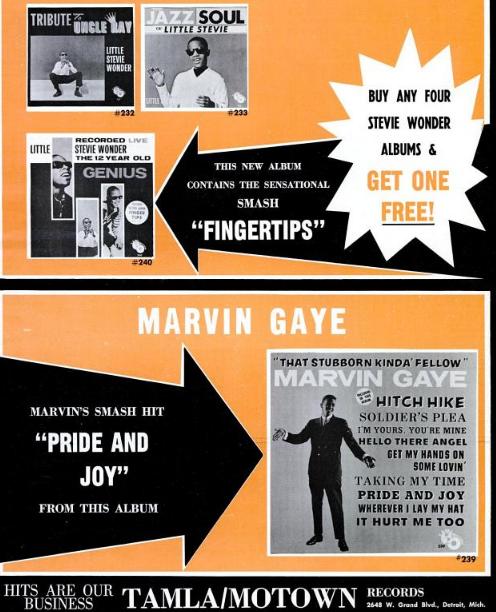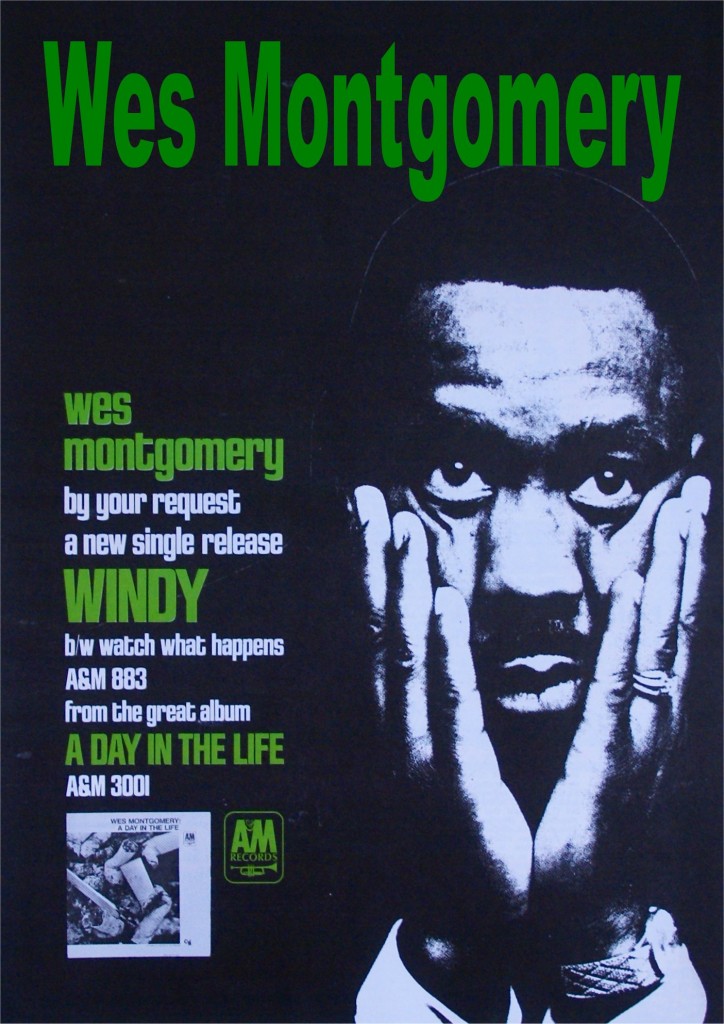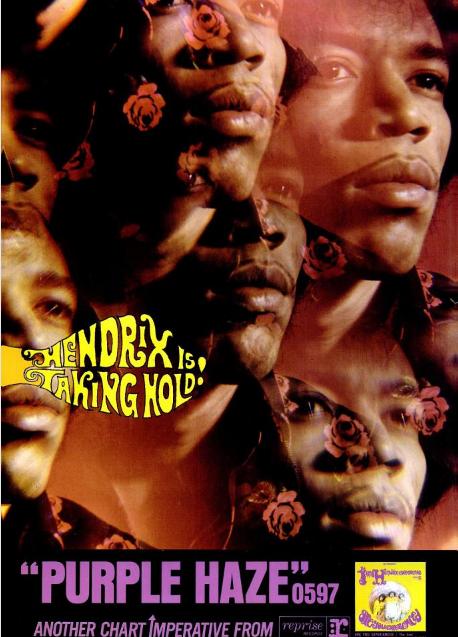![]()
Category: Flashbacks
PD LIKENS PROGRAMMING WKNR FULL-DAY JOB . . . MARCH 14, 1970
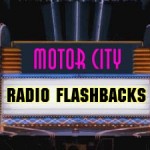 From the MCRFB news archive: 1970
From the MCRFB news archive: 1970
WKNR’s Broussard Makes Radio Programming Without Time Constraints While at Helm
DETROIT — It isn’t often you’ll see a radio station program director in a record store, let alone see one sitting there all day. And even less often you will see a program director there taking notes about what kind of people are buying what kind of records. Skip Broussard, a program director whose next job is to aid WKNR here and attempt to put it firmly into the ratings picture used information gained at record stores this way to built a pretty good success story in Knoxville at WKGN. He was involved in the same type of programming at WMPS, Memphis, until getting an offer for the Detroit job.
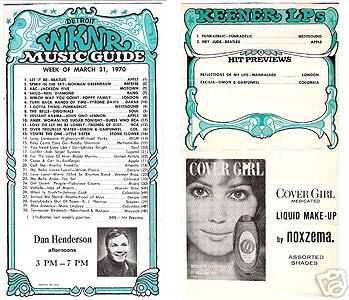
To gain a representative picture of the audience available in Memphis, Broussard surveyed record shops in all geographic locations of the city. “I found that in a area heavy populated with blacks, the stores would be selling some Beatles and other records by white artists. And, in a very posh area, the shop would be selling soul records. Some very high class whites were buying soul records especially high school kids and young adults of college age.
“There seemed to be a breaking down of the old barriers — at least in Memphis.”
Broussard spent at least one day each weekend for six weeks in local stores in Memphis. During the week, he sent his air personalities out to spend time in the record shops.
All of this data was translated into the station’s programming. Broussard admitted, “I was targeting a black and white audience. I was after the audience of the other pop station and the audience of WDIA, a soul station that has been No. 1 in Memphis for several years.”
The playlist under WMPS under Broussard’s direction became 50 per cent soul in nature, “but only the soul records that was selling to both white and black people. We were trying to avoid any ethnic image. If we could have gained both audiences, WMPS would have achieved giant ratings. And blacks listened longer so that would have helped ratings too.”
Research and Sales
WMPS based its playlist on the results of the in-store research, plus sales figures garnered by telephone and telephone requests from listeners. Each request over the phone was listed and identified by age. “Gradually, the black listeners grew as we added soul records,” Broussard said.
“This type of programming is a whole new untapped area. Many stations are afraid at the moment to play soul records — afraid it will drive off their white listeners. Bit I feel records don’t have to be considered black and white. Because black and white people are finally getting together. I can see it happening in the same degree that they’re digging each other’s music.
“The program director could play an extremely important role in racial harmony by giving both types of music exposure within the realm of good programming. When I get a black person requesting a record by a white, it makes me feel good. And the same goes for a white requesting a soul record.”
Broussard got his start in radio in 1961part-time working KSIG in Crowley, Louisiana, while attending the University of Southwest Louisiana at Lafayette. He later worked part-time at KALB in Alexandria, La., then became program director full time at KXKW, Lafayette while still attending school. In 1966, he joined WLCS in Baton Rouge , but after a year was called into the Army reserves for six months. Then he returned to WLCS for a year before joining WTIX in New Orleans as music director under program director Buzz Bennett. He was there two years and admitted he “learned a lot from Buzz Bennett during that two-year stint there.”
But after joining WKGN in Knoxville as program director, he took graduate courses in market research and the psychology of mass communications which also shaped his present theories on researching for programming.
“There are environmental factors in any market which stimulate and influence the people living there,” Broussard continued. “And these generally relate to music. In Memphis, there’s a heavy black population and it’s the home of the blues — these factors have influenced the whites towards the blues. A southern white animosity counteracts this slightly. But you’ll still find 50-60 percent of the records on WDIA’s playlist selling to whites, which would indicate some of their listeners are white. “WDIA,” he said, was playing such artists as the Beatles, Led Zeppelin, and Dusty Springfield at one time. I admire them for that. I don’t know who was responsible, but he was thinking big.”
An unusual factor about Memphis was that soul records companies provided poor record service to the pop stations, Broussard said. “Stax Records really didn’t work the white stations. Same with Motown Records. And its unfortunate. I wanted to play their records. These companies were missing the boat. Not just in record sales alone, but something much more important was missed than just putting out a finished product.” END.
(Information and news source: Billboard; March 14, 1970).
![]()
DETROIT RADIO SIDEBAR: WDRQ-FM BILLBOARD NOTES
 From the MCRFB notebook: 1971, 1981 and 1982
From the MCRFB notebook: 1971, 1981 and 1982
WDRQ-FM
DETROIT (June 10, 1971) — Al Casey has been slated to program Bartell’s St. Louis operation, which is still pending FCC approval, so he’s in Detroit programming WDRQ-FM. Andy Wilson is music director. Ron Thompson and Jay Stone are among the air personalities at the new Top 40 station in the Motor City. George Wilson, national director of Bartell, is managing WDRQ-FM. END.
DETROIT (August 1, 1981) — Bill Garcia, has been hired away from WDRQ-FM Detroit to be program director at WOMC-FM. Garcia has been moving the Hot 100 formatted WDRQ into a more adult contemporary mode and into direct competition with Metromedia’s WOMC. Charter Broadcasting has WDRQ on the block. Garcia succeeds Dave Shafer, who’s moved over to WCZY-FM, which is running the syndicated Shulke II vocal-oriented Beautiful music format. END.
DETROIT (January 30, 1982) — Alan Furst is the new program director at WEEP-AM in Pittsburgh, succeeding Barry Mardit, who has moved on to become program director at WWWW-FM in Detroit. Mardit succeeds Dene Hallan, who has left to become program director at WHN-AM New York (Billboard; December 12). Furst continues to work the 10 a.m. to 2 p.m.air shift. Furst is not the only new program director in the Motor City. Cliff Winston has taken over full programming duties at WDRQ-FM. Operations director at “The Q” Rick Torcasso has transferred to KSLQ-FM to program that station. Both WDRQ and KSLQ are owned by Charter Broadcasting. Torcasso succeeds John Larabee, who left the station. END.
(Information and news source: Billboard Magazine. All excerpts culled as was published from the dated editions noted above).
![]()
FLASHBACK ADS: TWO SMASH MOTOWN HITS * 1963
FLASHBACK ADS: WES MONTGOMERY HITS * 1967
FLASHBACK ADS: “PURPLE HAZE” * THE JIMI HENDRIX EXPERIENCE * 1967
BUBBLING UNDER HOT 100
![]()
HONEY RADIO 560: JUST LET THOSE GOOD TIMES ROLL
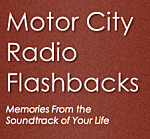 From the MCRFB NEWS archive: 1983
From the MCRFB NEWS archive: 1983
ANN ARBOR NEWS | June 14, 1983
STORY by BONNIE DeSIMONE (PHOTOS by DAVID M. DWORKIN)
OF THE NEWS STAFF / ANN ARBOR NEWS — June 14, 1983
B E F O R E T H E R E V O L U T I O N demanded a soundtrack and selling new videos demanded an accompaniment, pop music was charged with answering only a few essential questions:
Who put the bomp in the bomp buh-bomp buh bomp, who put the ram in the rama-lama ding-dong?
Who put the bop in the bop she-bop she-bop, who put the dip in the dip di-dip di-dip?
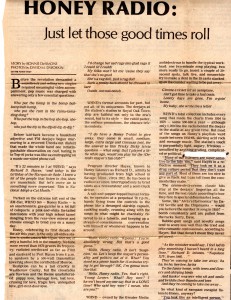
Before laid back became a household adjective and FM deejays began murmuring in a reverent Uncola-nut dialect that made the whole band one indistinguishable dissertation on cool, tuning in to Top-40 jocks was like eavesdropping on a manic one-sided phone call.
“It’s 22-minutes to 1 at WHND,” says Richard D. Hayes (click name for a Richard D. WHND aircheck October, 1994). “And today is the birthday of the Marquis de Sade. I know a lot of the people that listen to this show are masochists. But let’s move on to something more important. This is National Adopt-a-Cat month.”
Parked on the extreme left end of the AM dial, WHND 560 — Honey Radio — is an anachronistic gas-guzzler in a lot full of compacts, a pink-and-white fin-tailed datemobile with your high school tassel dangling from your rear-view mirror and chrome enough to blind you on a sunny day.
Honey, celebrating it’s first decade on the air this year, is the only all-oldies station in southeastern Michigan and one of only a handful left in the country. No tune more recent than 1970 graces it’s frequency, radiated northward as far as Flint and eastward to Port Huron from 6 a.m. to sundown by a 500-watt transmitter towering above the cornfields of Monroe.
Reception can be a tad crackly in Washtenaw County, but the crossfades are flawless and the theme unadulterated: puppy love, teenage love, lost love, cruising for love, tragic love, unrequited love, girl-next-door-love.
I’d change her sad rags into glad rags if I could (If I could). My folks won’t let me ’cause they say that she’s no good.
She’s a rag doll, just a rag doll. Such a pretty face should be dressed in lace. . .
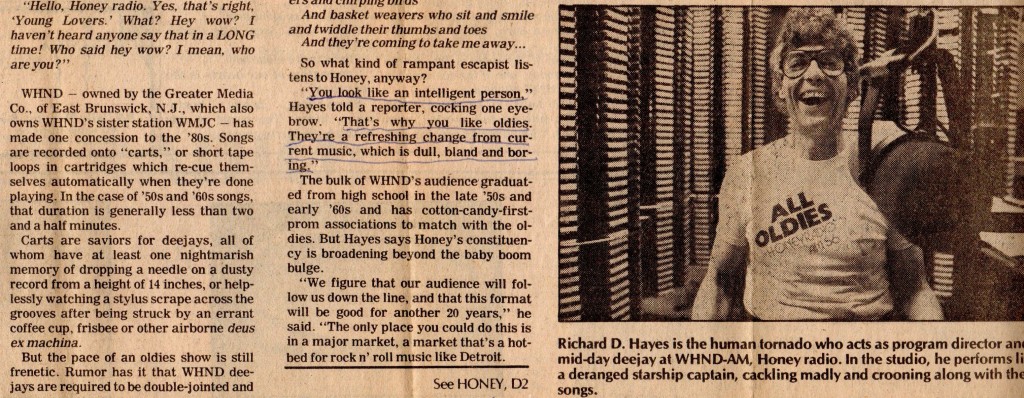
WHND’s format accounts for part, but not all, of it’s uniqueness. The deejays at the station’s Royal Oak Township are faithful not only to the era’s sound, but to its style — the rabid patter, the endless promotions, the obscure trivia contests.
“I do have a Honey T-shirt to give away, they come in small, medium, large, extra-large and Coleman tent for the answer to this Tricky Dicky trivia question — what song. that I played a little while ago, would you play for the (Detroit) mayor fan club?”
Program director Hayes, known to Honey listeners as Richard D., admits to having graduated from high school in Savage, Minn., circa 1952. He has been in radio ever since, interrupted only by brief stints as a restaurateur and semi-truck driver.
A salt-and-pepper topped human tornado, he operates at a perpetual 78 r.p.m., hands flying from the controls to the phone like a deranged starship captain, cackling madly, crooning along with the songs in what be charitably referred to as a falsetto, and keeping up a stream-of-consciousness conversations with himself or whomever happens to be around.
“Hello, Honey radio. Wipeout? You’re absolutely wrong. But that’s a good guess.”
“Hello, Honey radio. It isn’t Suspicion. No. Let’s keep the mayor’s personality and politics out of it. What? You stood in a phone booth fifteen minutes trying to get through? OK, I’m gonna mention that.
“Hello, Honey radio. Yes, that right, ‘Young Lovers.’ What? Hey wow? I haven’t heard anyone say that in a LONG time! I mean, who are you?
WHND — owned by the Greater Media Co., of East Brunswick, N.J., which also owns WHND’s sister station WMJC — has made one concession to the ’80s. Songs are recorded onto “carts,” or short tape loops in cartridges which re-cue themselves automatically when they’re done playing. In the case of ’50s and ’60s songs, that duration is generally less than two and a half minutes.
Carts are saviors for deejays, all of whom had at least one nightmarish memory of dropping a needle on a dusty record from a height of 14 inches, or helplessly watch a stylus scrape across the grooves after being struck by an errant coffee cup, frisbee or other airborne deus ex machina.
But the pace of an oldies show is still frenetic. Rumor has it that WHND deejays are required to be double-jointed and ambidextrous to handle the typical workload: one two-minute song playing, two more ready to go, insert a couple of 30-second spots, talk live, and meanwhile try to make a dent in the 18 carts stacked up on the counter waiting to be put away.
Gimme a ticket for an aeroplane, Ain’t got time to take a fast train, Lonely days are gone, I’m a-goin’ home, My baby, she wrote me a letter. . . .
WHND’s total collection includes every song that made the charts from 1954 to 1970 — some 500 to 800 a year — although only 1,200 line the racks behind the deejay in the studio at any given time. But most of the songs on Honey’s playlist were made between 1955-66, skirting rock and message music. The station’s touch is purposefully light, sugary, frivolous — unsullied by anything grating, complicated or political.
“Many of our listeners are super-sensitive to the late-’60s,” said Hayes in a reflective moment. “They look on it as a drug culture period that they don’t want any part of. Most of them are too nice to give us flack, but I can tell by the comments they make.”
The creme de-la-creme, classic hits stay at the deejay’s fingertips all the time, and the rest rotate according how they fare in special oldies market tests.
Some, like “Alvin’s Harmonica” by David Seville and the Chipmunks — would you believe the number 34 song in 1959? — bomb consistently and are pulled from the racks. Sorry, Dave.

Bubble-gum songs and novelty songs tend to score less well than the tried and trite romantic confessionals, according to Hayes. But that never means they never get aired.
“As the minister would say, I feel led to play something I haven’t heard in a long time,” Richard D. intones. “Napoleon XIV, from 1966. . .
They’re coming to take me away, ha ha, ho ho, he he, ha ha To the funny home, with trees and flowers and chirping birds And basket weavers who sits and smiles and twiddle their thumbs and toes And they’re coming to take me away . . . .
So what kind of rampant escapist listens to Honey, anyway?
“You look like an intelligent person,” Hayes told a reporter, cocking one eyebrow. “That’s why you like oldies. They’re a refreshing change from current music, which is dull, bland and boring.”
The bulk of WHND’s audience graduated from high school in the late ’50s and early ’60s and has cotton candy first-prom associations to match the oldies. But Haye’s says Honey’s constituency is broadening beyond the baby boom bulge.
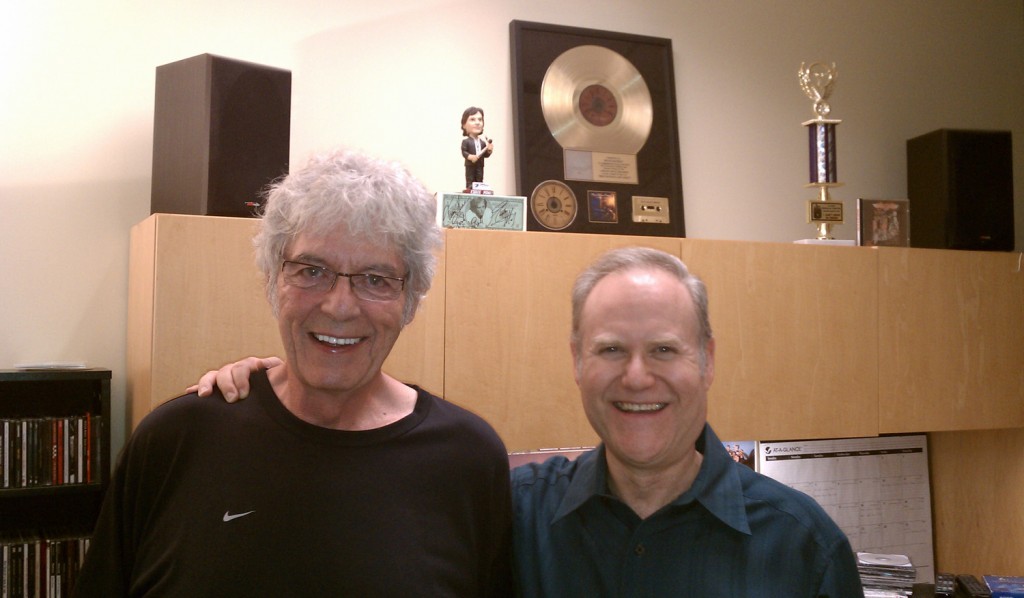
“We figure that our audience will follow us down the line, and that this format will be good for another 20 years,” he said. “The only place you could do this is a major market, a market that’s a hot bed for rock and roll music like Detroit.
“The music is suggestive of an era that people perceive of happy. Those were actually very turbulent times — I know, because I was an adult then. But people are unhappy with the way things are, and they want to go back to another era.
“And they’re not just weirdos anymore,” he said in some wonderment. “I’m seeing more and more younger people, more and more ordinary people.”

We used to dance to the music, make romance to the music. Oh, its the same old song, but with a different meaning since you’ve been gone . . .
But enough heavy stuff. Richard D. is on again — leg jiggling furiously, cranking the music so the music glass quivers, putting his swivel chair in reverse to answer the phone, chortling gleefully as he flips the switch so a caller can introduce a song, taking the mike himself.
“One of the reasons I’m SO excited today, one of the reason I’m EXUDING enthusiasm. . .”
“It’s hard to be down when you’re playing this music,” said Hayes. “Sometimes I come in and feel like a dishrag whose usefulness is past, but after a half an hour. . .”
I think we’re alone now. There doesn’t seem to be anyone around. I think we’re alone now. The beating of our hearts is the only sound . . . .
Bomp-bomp, bomp; Bomp-bomp, bomp. The sounds of our hearts is the Mersey beat. END
THANK YOU! Motor City Radio Flashbacks is indebted to our good friend Jim Heddle, Phoenix, AZ., for sharing this WHND ‘Honey Radio’ newspaper cut-out from June 14, 1983. We thank you for sharing with us this WHND ‘Honey Radio’ 560 Motor City memory. How times fly. This featured article first appeared in the Ann Arbor News — thirty-long years ago.
![]()
